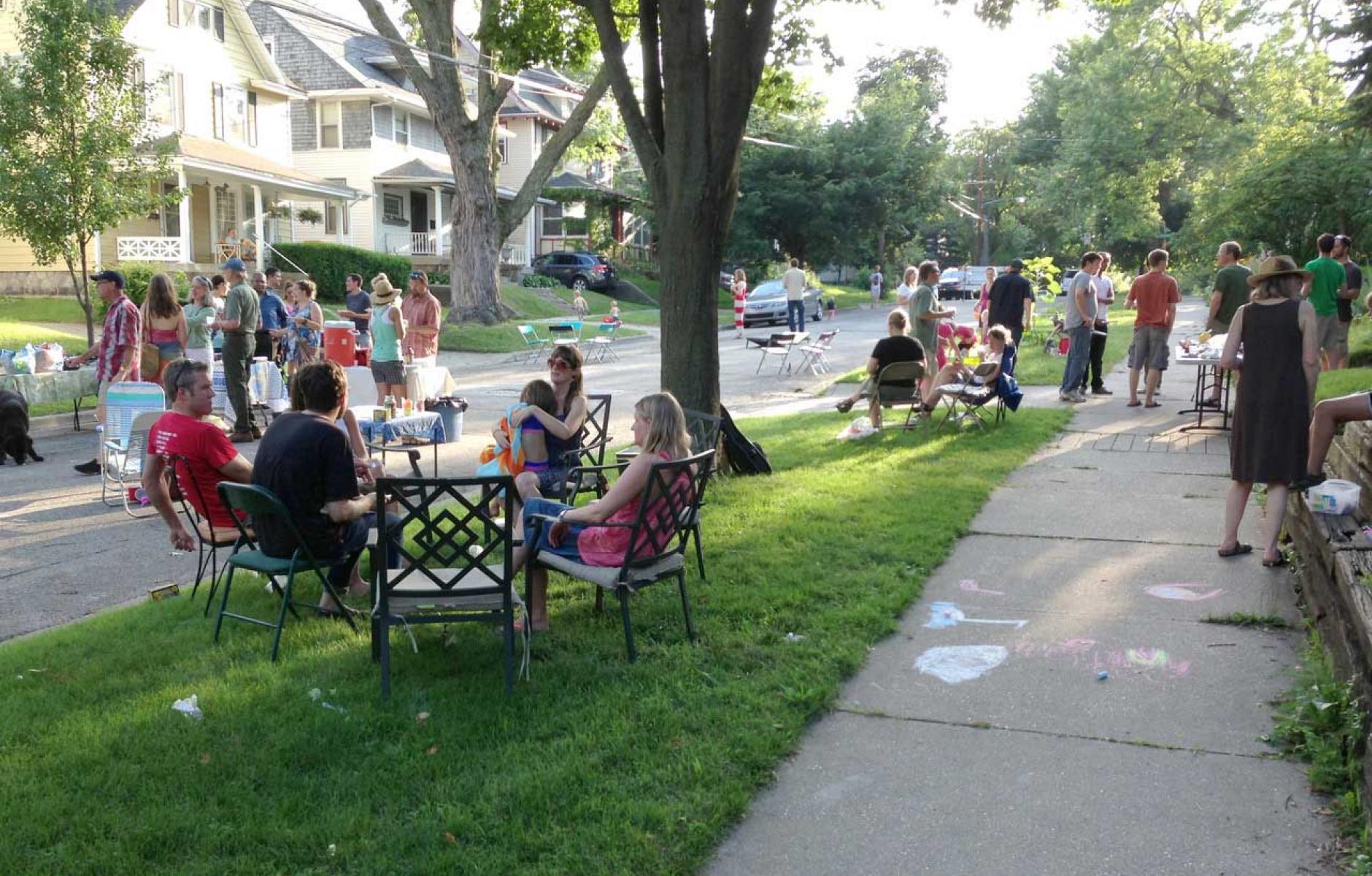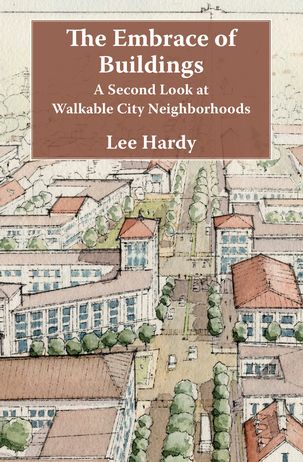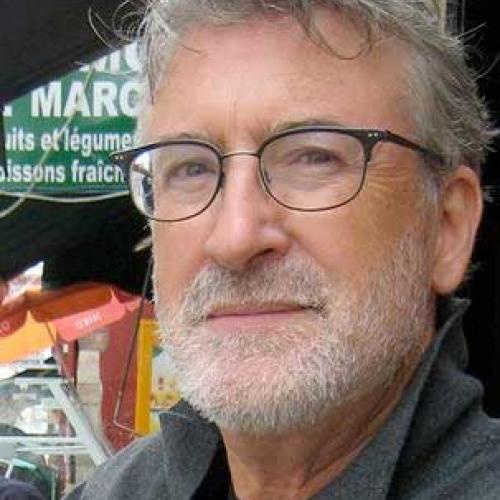
A philosopher embraces New Urbanism, at home and in the classroom
My flight was scheduled to arrive at LAX at 11:30 in the morning. Perfect, I thought. I could get a rental car and be out of Los Angeles before rush hour, heading up the California coast to visit my father by mid-afternoon. But my plans were spoiled by a thunderstorm in Chicago, which added five hours to my travel time. I arrived in LA at 4:30, picked up the rental car, and quickly got on the 405 northbound. It then took me one hour to go eight miles. And there were miles of heavy traffic still in front of me. Exasperated, I imagined an aerial view of my situation: surrounded by hundreds of cars on an expressway that now looked more like a linear parking lot. Clearly something was wrong with this picture.
Since my ill-timed visit, the 405 underwent a $1.6 billion construction project to ease traffic by expanding its capacity. After adding a travel lane and a set of new on- and off-ramps, the results are in: according to a study of the LA County Metropolitan Transportation Authority, the 405 is now even more congested between the hours of 4:30 and 6:30 pm. The results could have been predicted. Adding capacity to highways rarely reduces traffic congestion. It just invites more drivers. The phenomenon is known as “induced traffic.” We have known about it for years. And yet we keep spending tax dollars on the same old solutions, which often just make things worse.
I am a philosopher by training. But I have written a book on urban design. Much of the content of The Embrace of Buildings is drawn from an interim course on urbanism I’ve been teaching for the last ten years at Calvin College in Grand Rapids, Michigan.

When people ask me how I got interested in urban issues, my short answer is: “I grew up in LA.” My long answer is that I grew up in Fullerton, in Orange County, about 35 miles southeast of LA, during the 1960s. At the beginning of that decade, Orange County was a collection of distinct towns surrounded by orange groves and bean fields. My father owned a drugstore on Harbor Boulevard, the main street of Fullerton, which would take you to Newport Beach after a half-hour drive to the south. As a child I performed a variety of menial jobs in the store, often pausing to listen to conversations my father held with his regular customers, who also seemed like his friends. Lives were shared; local affairs discussed. Later I supplemented my income by filling in for my friends who delivered The Fullerton News-Tribune, the local paper, on the east side of town.
By the mid-1960s, the character of the region was changing rapidly. A carpet of housing subdivisions, shopping malls, parking lots, freeways, and gas stations was being rolled out from LA. Soon the orange groves and bean fields disappeared, and Orange County became one vast undifferentiated conurbation. It was difficult to tell when you left one town and entered another. The towns themselves had been gutted as retail moved out to the malls. Typical travel distances lengthened, and traffic became a serious problem. The Fullerton News-Tribune folded and became a weekly section of The Orange County Register. When asked by outsiders where they lived, people rarely named their town anymore. They just said, “Orange County.” It didn’t seem to matter where you lived, as long as you were reasonably close to a highway and the TV reception was good. At the end of his career, my father worked for a chain drugstore in a supermarket far removed from his place of residence. His customers were strangers to him, and remained so. Just about all traces of civic life and identity, it seemed, had evaporated.
The pattern of post-World War II development I witnessed in Orange County struck me as fundamentally wrong-headed. But others appeared to accept it as inevitable and somehow normal. I found few people voicing concerns. Until, in September of 1996, I read an article in The Atlantic by James Howard Kunstler. The article was drawn from his earlier book, The Geography of Nowhere, and previewed his forthcoming book entitled Home from Nowhere. In that piece, Kunstler articulated all the private feelings I had been harboring about urban sprawl, often in sustained and delightful runs of purple prose. Underneath his impassioned writing style, however, lay a solid analysis of the effects and drawbacks of functional zoning and automobile dependence.
Following up on that lead, I soon discovered the existence of the Congress for the New Urbanism, an organization of architects, city planners, and citizen activists devoted to the retrieval of classic urban form and the creation of walkable city neighborhoods. I joined the Congress and attended many of its national conferences. I delved into the literature on urban design and the cultural history of cities. I did coursework at the University of Miami School of Architecture. I studied cities as I traveled in North America, Europe, and Asia. I made contacts with like-minded architects, planners, and developers in the Grand Rapids area, and then began to offer a course on urban design during the January interim at Calvin College.
The New Urbanist movement was controversial when it came together in the mid-1990s. But its sentiments, it seemed to me, were little more than a straightforward extension of common sense. Consider the opening statement of its Charter, adopted in 1996: “The Congress for the New Urbanism views disinvestment in central cities, the spread of placeless sprawl, increasing separation by race and income, environmental deterioration, loss of agricultural lands and wilderness, and the erosion of society’s built heritage as one interrelated community-building challenge.” Clearly the problems identified by the Congress were genuine problems. Or so I thought. Its agenda also seemed to me to be on the right track: “We stand for the restoration of existing urban centers and towns within coherent metropolitan regions, the reconfiguration of sprawling suburbs into communities of real neighborhoods and diverse districts, the conservation of natural environments, and the preservation of our built legacy.”
Moreover, the recommended means and guidelines of the Congress appeared well-fitted to its proposed ends: “We advocate the restructuring of public policy and development practices to support the following principles: neighborhoods should be diverse in use and population; communities should be designed for the pedestrian and transit as well as the car; cities and towns should be shaped by physically defined and universally accessible public spaces and community institutions; urban places should be framed by architecture and landscape design that celebrate local history, climate, ecology, and building practice.” I could find much to affirm and little to argue with in the Charter.
Answering the critics
Nevertheless, the New Urbanism has had its share of critics. Some hold that it subscribes to a version of “architectural determinism,” as if getting the physical form of cities right would somehow guarantee a well-functioning human community. I have yet to meet a new urbanist who holds such a view. In fact, this objection is anticipated in the fourth paragraph of the Charter: “We recognize that physical solutions by themselves will not solve social and economic problems, but neither can economic vitality, community stability, and environmental health be sustained without a coherent and supportive physical framework.” Good urban form is best thought of as an enabling condition, not an all-determining factor.
Others have criticized New Urbanism because many new developments built along its principles occupy higher price points in the real estate market. They tend to be exclusive and unaffordable. The high prices, however, reflect the level of demand for such places. They are indeed attractive. And rare. The solution to that problem is to build more of them, not less.
New Urbanism has also been criticized as a pointless exercise in nostalgia, a futile attempt to turn back the clock to the quaint towns and neighborhoods of yesteryear, when in fact the future marches on, inexorably, to bold new experiments in oddly shaped glass towers, massive superhighways, and electronically assisted automotive transportation. In response to this claim, I can only point out that what comes later in time does not always represent true progress. As C. S. Lewis reminded us in Mere Christianity, “We all want progress. But progress means getting nearer to the place where you want to be. And if you have taken a wrong turning, then to go forward does not get you any nearer. If you are on the wrong road, progress means doing an about-turn and walking back to the right road; and in that case the man who turns back soonest is the most progressive man.” In The Embrace of Buildings, I argue that low density, auto-oriented development is in fact taking us down the wrong road, and that turning back to rediscover the principles of classic urban form represents a step in the right direction.
Finally, it has often been said that New Urbanism is doomed to failure because it will never get Americans to abandon their cars. But that was never the aim of the movement in the first place. The point is to promote the creation of places where driving remains an option, but is not a necessity, places where alternate modes of transit are available. The addition of transit options not only serves the one-third of Americans who do not—or cannot—drive; it also makes it possible for some households to reduce the number of cars they must own, thus saving thousands of dollars a year.

My interest in walkable city neighborhoods is not merely theoretical. It’s also part of my experience. I have lived in such a neighborhood in Grand Rapids for the past 30 years. It goes by the name of Eastown. It’s an old streetcar suburb that was largely built out in the 1910s, before car ownership was widespread. People, primarily professionals in that day, would take the streetcar downtown to work, return, and walk home. Home may have been a single-family detached house. Or it may have been a duplex or apartment. Eastown contains a variety of residential options. The neighborhood had its own retail section that supplied residents with their daily and weekly needs within a comfortable walking distance.
Much has changed since then. A good number of buildings have been lost to parking lots. Some of the retail has moved out to big box stores on the edge of the city. But the community still has good bone structure, a fine network of connected streets. And many walkable destinations. Within a five-minute walk of my house lies a farmer’s market, a supermarket, three churches, two elementary schools, a civic theater, two coffee shops, a pizza parlor, a donut shop, three restaurants, two bakeries, a brewery, a park, a college, a creek, two used-book stores, a shoe store, a yoga studio, a massage therapist, two beauty salons, a gift shop, a gym, a butcher shop, a delicatessen, a post office, a bike shop, and a bus stop. My wife and I make do with one car, since I can ride my bike or moped to work in fair weather and take the bus in foul.
Our four children, now grown, have fond memories of living in a neighborhood where they could walk to the park and its playground, to the supermarket for candy, or to the coffee shop for hot chocolate with their friends. They grew up in a house where the front porch was just eight feet back from the sidewalk, and the neighbors’ houses were just eleven feet to each side. In the summers the doors of the houses on our block were open, and they and their friends easily circulated from house to house and yard to yard under the welcoming and watchful eye of their adult neighbors. Once a year we close the street for a block party. Then not only the food but also the musical instruments come out, and the fire department often supplies a big red fire engine for the children to inspect. In the summers, on random Friday afternoons, someone will announce a spontaneous Happy Hour, and we’ll gather on a porch for drinks and hors d’oeuvres. Every December we go caroling with a group of about a dozen neighbors. Those among us who fall ill can expect visits and regular deliveries of prepared food. We have made many friends in our part of town, and many acquaintances. The built form of our neighborhood did not make us sociable; but it made it easier for us to be social.
This article appeared in The American Conservative and is adapted from Lee Hardy's new book The Embrace of Buildings: A Second Look at Walkable City Neighborhoods.




